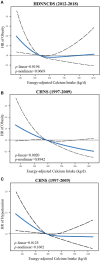Association of Dietary Calcium Intake With Bone Health and Chronic Diseases: Two Prospective Cohort Studies in China
- PMID: 35004796
- PMCID: PMC8740131
- DOI: 10.3389/fnut.2021.683918
Association of Dietary Calcium Intake With Bone Health and Chronic Diseases: Two Prospective Cohort Studies in China
Abstract
Background: Calcium is an essential element in our diet and the most abundant mineral in the body. A high proportion of Chinese residents are not meeting dietary calcium recommendations. The purpose of this study was to investigate the relationship between calcium intake and the health of residents in two longitudinal studies of Chinese residents. Methods: This study used nationally representative data from the Harbin Cohort Study on Diet, Nutrition, and Chronic Non-communicable Disease Study (HDNNCDS) and China Health Nutrition Survey (CHNS), including 6,499 and 8,140 Chinese adults, respectively, who were free of chronic diseases at recruitment, with mean values of 4.2- and 5.3-year follow-up. Cox's proportional-hazards regression was conducted to explore the relationship between dietary calcium intake and the incidence of obesity, type 2 diabetes, hypertension, and cardiovascular disease (CVD) with adjustment for covariates. Results: Calcium intakes were 451.35 ± 203.56 and 484.32 ± 198.61 (mean ± SD) mg/day in HDNNCDS and CHNS. After adjusting the covariates, the relationship between dietary calcium intake and bone mineral density (BMD) was not statistically significant (p = 0.110). In the multivariate-adjusted Cox's proportional-hazards regression model, dietary calcium intakes were inversely associated with obesity incidence in both cohorts (HR [95% CI]: 0.61 [0.48-0.77] and p trend < 0.001 in fixed-effects model); nevertheless, there was no correlation between dietary calcium intake and the risk of type 2 diabetes (p trend = 0.442 and 0.759) and CVD (p trend = 0.826 and 0.072). The relationship between dietary calcium intake and the risk of hypertension in the two cohorts was inconsistent (p trend = 0.012 and 0.559). Additionally, after further adjusting the vegetable intake in the original multivariate model, both cohorts found no association between dietary calcium intake and the risk of developing obesity (p trend = 0.084 and 0.444). Conclusions: Our data suggest that the current calcium intake of Chinese residents was inversely associated with obesity, which may be related to consumption of vegetables. Meanwhile, the current calcium intake does not increase the risk of type 2 diabetes, CVD, and bone health burden. This research suggested that the Chinese current calcium intake level may have met the needs of the body.
Keywords: bone mineral density (BMD); chronic disease; cohort study; dietary calcium intake; dietary reference intakes (DRI).
Copyright © 2021 Guo, Gao, Meng, Wang, Zhang, Song, Hu, Sun and Li.
Conflict of interest statement
The authors declare that the research was conducted in the absence of any commercial or financial relationships that could be construed as a potential conflict of interest.
Figures


Similar articles
-
Fruit, vegetable, and legume intake and the risk of all-cause, cardiovascular, and cancer mortality: A prospective study.Clin Nutr. 2021 Jun;40(6):4316-4323. doi: 10.1016/j.clnu.2021.01.016. Epub 2021 Jan 27. Clin Nutr. 2021. PMID: 33581953
-
Long-Term Low Intake of Dietary Calcium and Fracture Risk in Older Adults With Plant-Based Diet: A Longitudinal Study From the China Health and Nutrition Survey.J Bone Miner Res. 2016 Nov;31(11):2016-2023. doi: 10.1002/jbmr.2874. Epub 2016 Jun 9. J Bone Miner Res. 2016. PMID: 27208802
-
Dietary manganese and type 2 diabetes mellitus: two prospective cohort studies in China.Diabetologia. 2018 Sep;61(9):1985-1995. doi: 10.1007/s00125-018-4674-3. Epub 2018 Jul 3. Diabetologia. 2018. PMID: 29971528
-
Associations between Consumption of Dietary Fibers and the Risk of Type 2 Diabetes, Hypertension, Obesity, Cardiovascular Diseases, and Mortality in Chinese Adults: Longitudinal Analyses from the China Health and Nutrition Survey.Nutrients. 2022 Jun 27;14(13):2650. doi: 10.3390/nu14132650. Nutrients. 2022. PMID: 35807831 Free PMC article.
-
The Dietary Branched-Chain Amino Acids Transition and Risk of Type 2 Diabetes Among Chinese Adults From 1997 to 2015: Based on Seven Cross-Sectional Studies and a Prospective Cohort Study.Front Nutr. 2022 May 23;9:881847. doi: 10.3389/fnut.2022.881847. eCollection 2022. Front Nutr. 2022. PMID: 35677550 Free PMC article.
Cited by
-
The association between serum magnesium and chronic kidney disease in Chinese adults: a cross-sectional study.BMC Public Health. 2024 Jan 15;24(1):187. doi: 10.1186/s12889-023-17615-2. BMC Public Health. 2024. PMID: 38225595 Free PMC article.
-
Impacts of people at-risk of either cow milk allergies or lactose intolerance on their daily calcium intake and bone mineral density.Front Nutr. 2024 Aug 16;11:1421275. doi: 10.3389/fnut.2024.1421275. eCollection 2024. Front Nutr. 2024. PMID: 39221165 Free PMC article.
-
Association between dietary calcium and depression among American adults: National health and nutrition examination survey.Front Nutr. 2023 Feb 9;10:1042522. doi: 10.3389/fnut.2023.1042522. eCollection 2023. Front Nutr. 2023. PMID: 36845060 Free PMC article.
-
The association between dietary quality index- international and metabolic risk factors in RaNCD cohort study.BMC Public Health. 2024 Oct 30;24(1):3002. doi: 10.1186/s12889-024-20513-w. BMC Public Health. 2024. PMID: 39478517 Free PMC article.
References
-
- Nappo A, Sparano S, Intemann T, Kourides Y, Lissner L, Molnar D., et al. . Dietary calcium intake and adiposity in children and adolescents: Cross-sectional and longitudinal results from IDEFICS/IFamily cohort. Nutr Metab Cardiovasc Dis: NMCD. (2019) 29:440–9. 10.1016/j.numecd.2019.01.015 - DOI - PubMed
LinkOut - more resources
Full Text Sources
Miscellaneous

